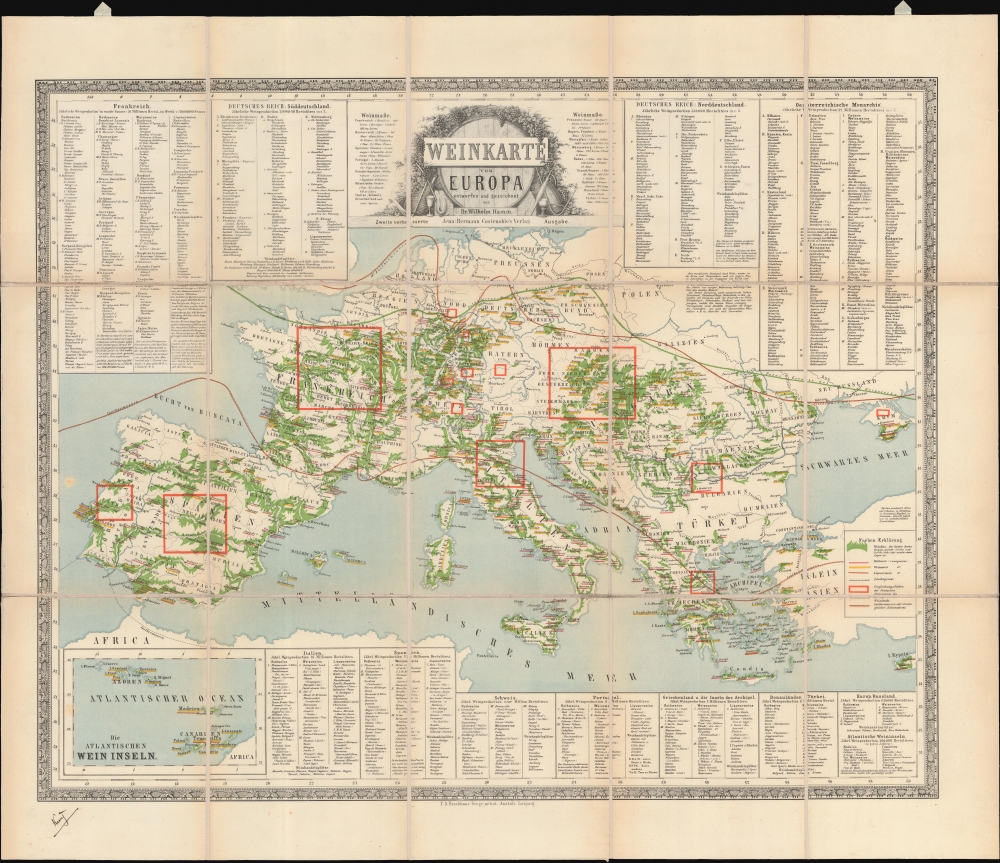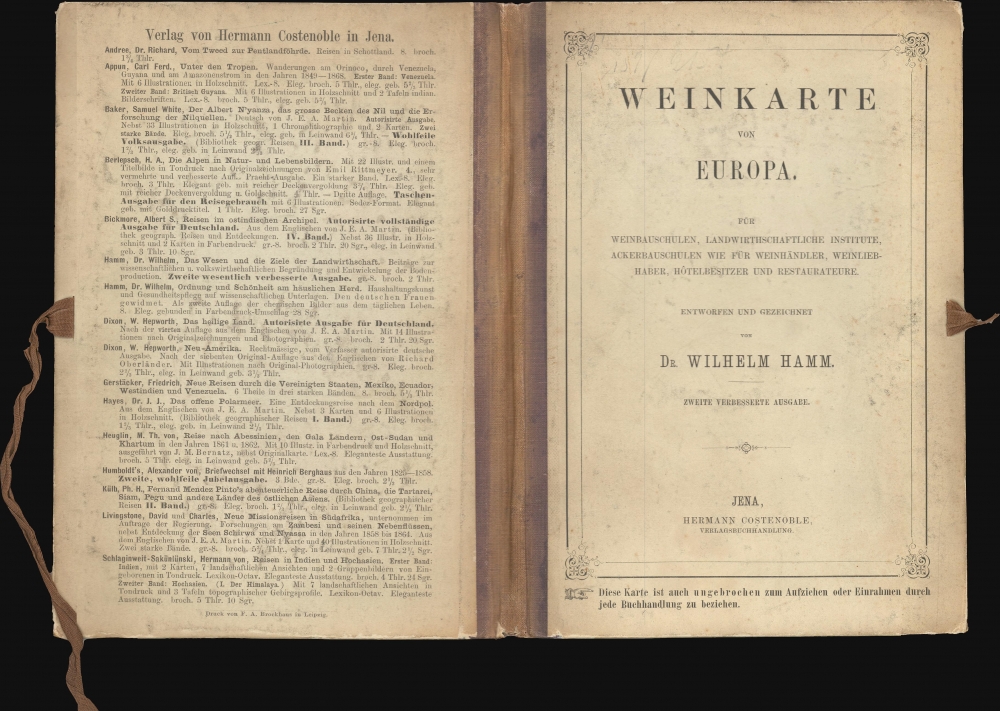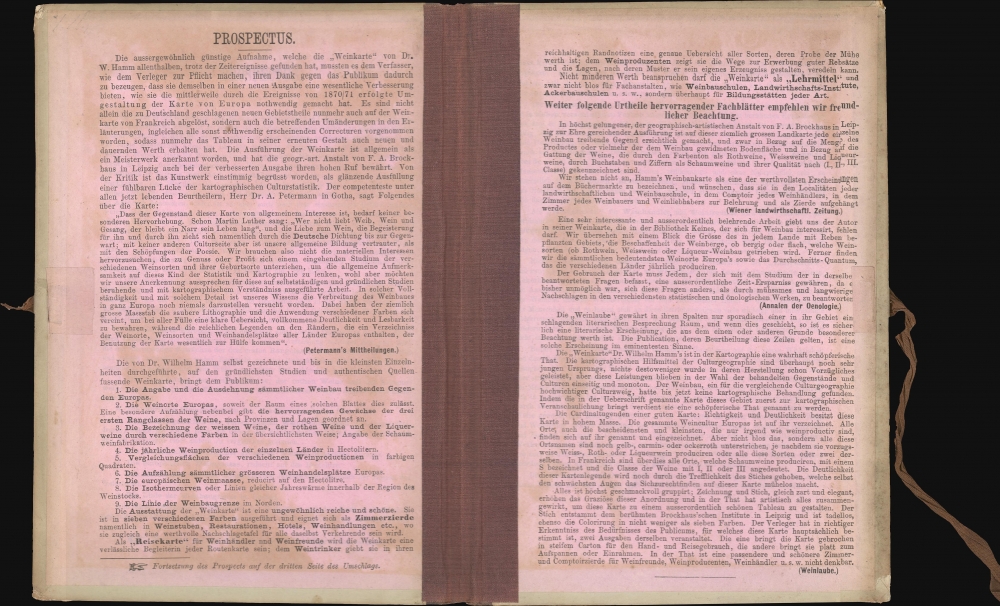
This item below is out of stock, but another example (left) is available. To view the available item, click "Details."
Details
1871 Hamm Wine Production Map of Europe
$2,000.00
1871 Hamm Wine Production Map of Europe
WiencarteEuropa-hamm-1871
Title
1871 (dated) 24 x 28 in (60.96 x 71.12 cm) 1 : 4350000
Description
A Closer Look
The map encompasses the wine-producing regions of Europe - essentially those territories south of Brussels and Krakow, north of the Mediterranean. Specific wine-producing regions are highlighted in green. Surrounding the map are tables breaking down wine production by country, varietal, and region, with production quantities noted in hectoliters. Red boxes correspond with each table, highlighting non-specifically, the regions referenced. Additional tables on either side of the cartouche offer production statistics. An inset map in the lower left details wine production in Madeira, the Azores, and Canary Islands.Publication History and Census
This map was compiled by the Austrian-German agronomist Wilhiem Hamm and published in Jena by Hermann Costenoble. It was printed by F. A. Brockhaus in Leipzig. The map was introduced in 1869 and is represented here in its 1871 second edition. All editions are exceedingly rare. We note an example of the 1865 edition in the Library of Congress, as well as about 11 other holdings, various editions, mostly in German institutions. No history on the market.CartographerS
Wilhelm Philipp Ritter von Hamm (July 5, 1820 – November 8, 1880), a.k.a. Philipp Emrich, was a German-Austrian chemist, agronomist, politician, and wine enthusiast. Hamm was born in Darmstadt, the son of a Grand Ducal Chamberlain of Hesse-Darmstadt. He studied chemistry at Justus-Liebig-Universität Giessen where he joined the influential student organization, Corps Teutonia Giessen. After graduating he worked on several Hessian estates until about 1838, when he moved to the Hohenheim Agricultural and Forestry Academy near Stuttgart. At this time he developed an interest in the emerging engineering discipline of agricultural machinery, on which he wrote the famous 1845 work, The Agricultural Machinery and Equipment of England . In 1847, he relocated to Leipzig and assumed the role of editor for the Agronomische Zeitung. The following year, in 1848, he participated in the Schleswig-Holstein Campaign, serving as an officer in the Tann Freikorps. In 1851, he founded an agricultural machinery factory in Eutritzsch, near Leipzig. From 1862, he was a member of the Leipzig city council and was a deputy member of the Second Chamber of the Assembly of the Estates of the Kingdom of Saxony. In 1867, he moved to Vienna to take a position with the Ministry of Commerce. In that capacity, he was sent with the Austrian delegation to the opening of the Suez Canal. He also published biographical and poetical works. In culinary circles, he is well known for his 1865 treatise on wine, Das Weinbuch [The Wine Book} and a related Weincarte of Europe. More by this mapmaker...
Wilheim Hermann Costenoble (March 20, 1826 - February 25, 1901) was a German bookseller, author, and publisher based in Jena, Germany. Costenoble was born in Magdeburg, Sachsen-Anhalt, Germany. He became a prominent bookseller and publisher in the mid to late 19th century, publishing under Verlagsbuchhandlung Hermann Costenoble, or just 'H. Costenoble'. Costenoble gained a reputation for publishing significant works associated with major German literary and intellectual movements of the 19th century. The publishing enterprise seems to have vanished after his death. Significantly, his son, Ludwig Wilhelm Hermann Costenoble (1867 - 1936) was the first German immigrant to the German colony in the Marinara Islands. In 1902, he acquired a 99-years lease on some 200 hectares of near Saipan. He failed in farming those lands due to infighting with local officials, and in 1904, relocated to American-administered Guam, where in 1910 he became Chief Forester. Some unknown scandal led to his arrest and, upon release 3 months later, he move to Manila, Philippines. He, or one of his children, are credited with writing in 1940 the first work on Chamorro, the indigenous language of Guam and the northern Marinara Islands, Die Chamoro Sprache. Learn More...
Friedrich Arnold Brockhaus (May 4, 1772 - August 20, 1823) was a German publisher and editor. He was born in Dortmund and from 1788 - 1793 apprenticed at a mercantile concern in Düsseldorf. He subsequently studied language and literature at the University of Leipzig, then went on to establish a Dortmund-based concern importing and selling English goods. He developed his business in Amsterdam for a time before economic pressures forced him to close. He turned to publishing, founding 'F. A. Brockhaus', in 1805. The firm was initially based in Amsterdam, but in 1811 relocated to Altenburg, Germany, then, in 1818, to Leipzig. There he established a large printing house dedicated to encyclopedias, scientific publications, and literature. Friedrich Arnold died in Leipzig in 1823, but the business was taken over by his sons, Friedrich Brockhaus (1800 - 1865), who retired in 1850, and Heinrich Brockhaus (1804 - 1874), under whom it was considerably extended. Their most significant publication was the Brockhaus Enzyklopädie, also known as Der Grosse Brockhaus. In 1953, after World War II (1939 - 1945), its Leipzig operations were nationalized by East Germany. Its West German successor established itself in Wiesbaden. Following German reunification, corporate headquarters were moved to Munich. The firm continues to publish as F. A. Brockhaus AG. Learn More...






